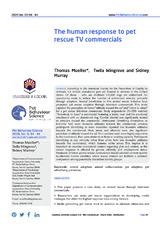The human response to pet rescue TV commercials
Autor
Mueller, Thomas
Wingrove, Twila
Murray, Sidney
Editor
Universidad de Córdoba, Departamento de Medicina y Cirugía AnimalFecha
2020Materia
Animal adoptionAnimal euthanization
Pet adoption
Pet advertising
Pet rescue
METS:
Mostrar el registro METSPREMIS:
Mostrar el registro PREMISMetadatos
Mostrar el registro completo del ítemResumen
According to the American Society for the Prevention of Cruelty to Animals, 6.5 million abandoned pets are housed in shelters in the United States. Of those who are sheltered 670,000 dogs are euthanized. An opportunity exists to reduce the number of euthanized animals, primarily through adoption. Several benefactors to this animal rescue initiative have prompted pet rescue adoption through television commercials. This study explored the perception of viewer“attitude toward the ad”and“intent to adopt” for a pet rescue television commercial. Study respondents (N=335) watched “Somebody to Love” a commercial featuring a lonely man and his emotional attachment with an abandoned dog. Gender identity was significantly related to attitudes toward the commercial. Participants identifying themselves as feminine held more favorable attitudes towards the commercial, whereas participants identifying as more masculine reported less favorable attitudes towards the commercial. Work status and ethnicity were also significant predictors of attitude toward the ad. Non-workers were more highly responsive to the commercial, than were students or those in working capacity. Participants identifying as any ethnicity other than white held less favorable attitudes towards the commercial, which features white actors. This implies it is important to examine commercial content regarding plot and context, as the viewer response is affected by gender, ethnicity and employment status. Producers of future animal rescue commercials should consider content specific to alternate human identities, where rescue animals can facilitate a common compassion among potentially discordant identity groups.

